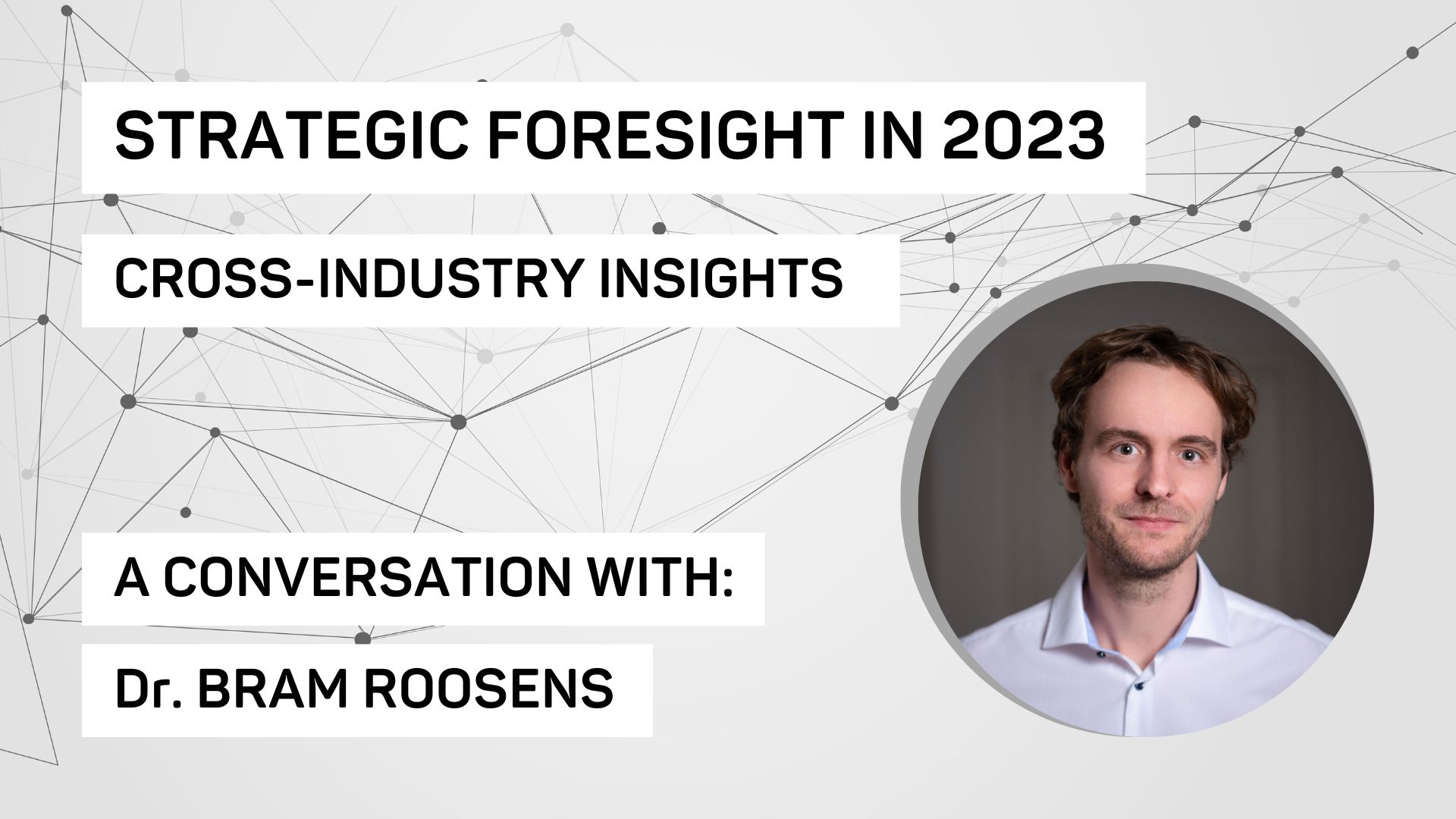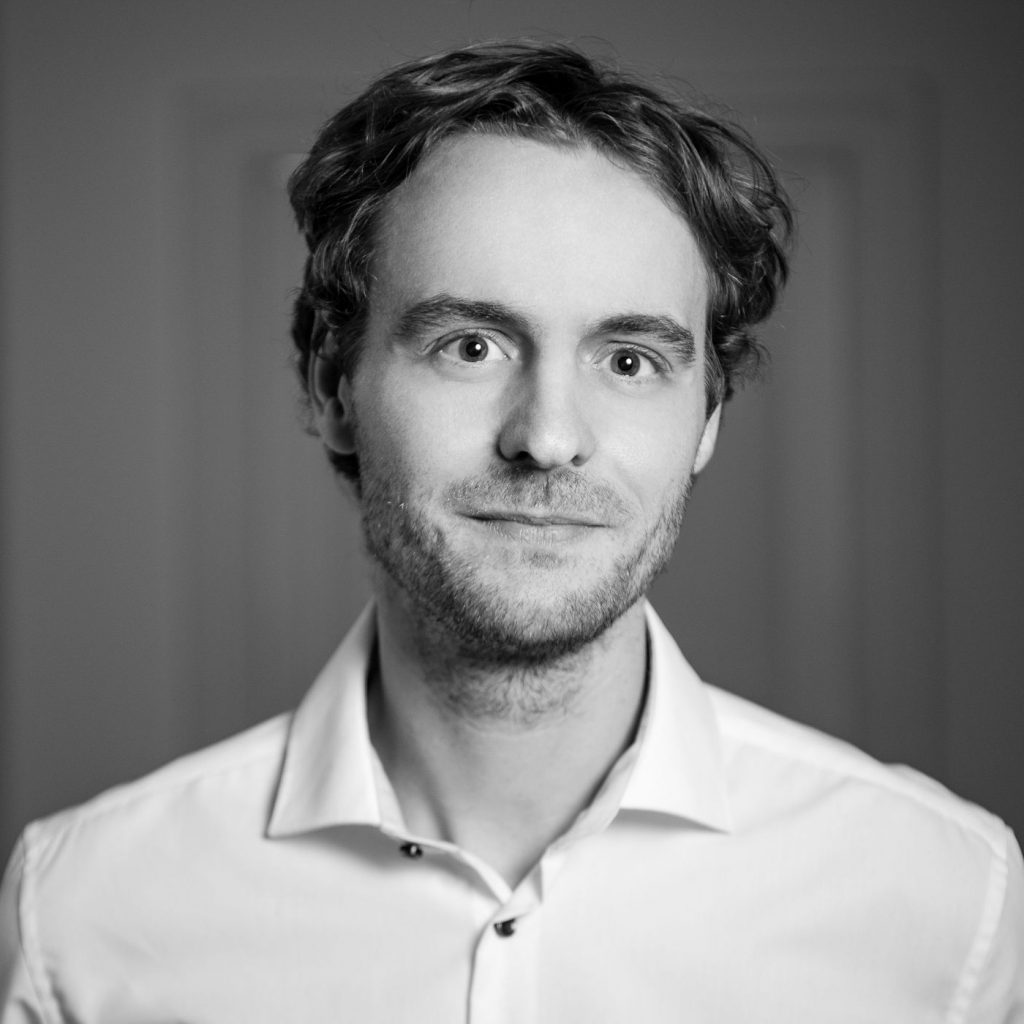
Strategic Foresight in 2023: Cross-industry insights (3/3)
In conversion with Bram Roosens, our innovation and foresight expert on what’s set to impact business this year
By Emily Phillips
Dr. Bram Roosens is a Senior Consultant at Rohrbeck Heger, specializing in Foresight-Driven Innovation projects. His work often takes him on location to collaborate directly with clients, working closely with their teams for longer periods of time. Read on to learn more about what it’s like to develop moonshots for a multinational, the importance of stakeholder engagement, and which emerging trend clients should focus on, next.
Read our other instalments in this three-part series with Manager, Dr. Alejandro Berbesi and Senior Consultant, Philipp Maron
Tell us about the projects you’ve worked on this past year.
Bram: I’ve been working with a global Fortune 500 company on a 10-year plan for their R&D center. We call it a moonshot program, working on what would be very long-term innovation opportunity areas, thinking about breakthrough technologies and radical solutions to the future’s problems. We mainly focus on opportunity areas where we don’t yet know how we’d be able to realize a proposed solution. These are innovations that from today’s POV, it’s not even clear how to implement them! But together with the client we’ve identified their ambition to move into that space over the next 10 years.
What’s been most interesting was enabling a mindset shift. This company was working from a quite short-term oriented perspective, and with good reason: historically, their industry has been quite stable with well-established supply chains and steady demand from consumers. But today, an interesting mix of STEEP factors is driving change in the industry. That’s where they needed the foresight perspective, dealing with the uncertainty of the future for their business model. We’ve really brought a long-term perspective to the company, working together with a great and super dedicated team from their side.
“Foresight is so relevant for so many parts of the organization: HR, marketing, strategy, innovation. I see it becoming a capability of each organizational unit.”
– Bram Roosens
You’re looking 10 years out and developing moonshots for things that don’t even exist, yet! How do you keep your mindset so far in the future, and not “fall back” to what’s possible, now?
It’s never easy, but we made it very clear from the start that this was our ambition. The client organization already went through a similar approach the year prior and had tried to come up with these ideas. Unfortunately for them, they didn’t manage to look beyond a 3-5 year horizon. That was an interesting position for us to be in because there was quite some pressure; the client was giving it another try, so you want to make sure that it lands! On the other hand, it made the client very open for us to push them and say, “okay, this is the ambition, let’s think really far ahead.”
We started off with letting them think very, very creatively, 20-30 years into the future. How will we consume in 2050? We had several training sessions on nonlinear thinking and radical innovation. The scenario-based approach really helped there, too, so that step by step, the client imagined alternative plausible futures. By encouraging different stakeholders to join in scenario development, you really saw that people started owning the scenarios. They started mentioning the scenarios all the time! So much so that in workshops, when we almost forgot about a scenario, they would remind us! By creating scenarios with people from the organization, these scenarios become part of the organization and people tend to think way more creatively throughout the process.
You mentioned the relationships with the client’s internal team that you were able to build, and the stakeholder engagement and internal knowledge you were able to leverage. Can you share more about that experience?
Bram: As a whole, Rohrbeck Heger commits to co-creating a process with clients. This is super important for the simple reason that every organization is different. You can only know how things are done when you talk to people and work together with people within the organization, trying to join meetings with their internal stakeholders, listening in and working to understand: what’s being talked about? What concerns do senior leadership have?
We aim to take all that into account when going into a process like this, being very flexible and adapting to the client’s needs. For example, one of the reasons that their first experience with foresight didn’t go very well was that people were only familiar with the short-term strategy. So what we did was say, “okay, let’s schedule insight sessions with their long term strategy team.” The corporate strategy team, who is also working on a 10-year plan, should provide input, as should the sustainability team, the legal team. All of these actors can provide their outlook on the future. And by doing so we got buy-in from these stakeholders because they were involved from early on in our process. Stakeholder management is critical.
By doing all of this, as an external, you also get to know the organization really well. This means that you’re better able to advise, as you learn about how the organization works and adapt/change your process based on what you see happening. For example we knew that most of the client’s processes and targets erred towards the short term. We started talking with people, asking: where did it go wrong? Why hadn’t you come up with really crazy ideas? Once we understood this, we could, for example, add more training initiatives to get people into a longer-term/future-focussed mindset.
You worked on another big project this year, what can you share about that one?
Bram: The other big project is with a second global Fortune 500 company. With this client, we’ve been working on embedding systematic foresight capabilities within the organization. We built a concept for them back in 2021 and since then have been ramping up foresight practices in the company, focussing on implementing a systematic approach. We see that a lot of great foresight and market research is done in big corporates, leading to an abundance of ‘new’ input every year. But it’s often already focused on and limited to specific search fields and areas that they’re interested in. They might produce a great trend report based on this, and share that throughout the organization. But what we try to do is to make sure that we capture all these trends on a continuous basis. For that we implemented a trend radar, and began using that radar as the basis for foresight processes. Then you have a good basis to start from, you can use the filter and radar functions to define key focus areas, and then deep dive into these specific projects.
Then we analyzed the innovation portfolio compared to the trends we had identified. We reviewed this with senior leadership and key stakeholders, and together identified what the client now understands to be the most impactful trends for their business, trying to figure out: “what are trends that are impactful, but that are not reflected in our innovation portfolio?” This is how we identify certain areas that require more strategic focus.
At this juncture we start the process of opportunity identification. We did a workshop series with key internal stakeholders. The opportunity areas that came out of that sprint were not only invented there, some of them were things that people were already thinking about from different directions. This process, however, validates them and there are opportunity and innovation areas that are now moving on into real, big potential innovation project ventures. Some of these were even presented to the CEO just last week! So that is quite nice to see. And we will continue to work with this client, which makes me quite proud because I can say that we are a partner in this, it’s not just a one-off project.
What are some common insights you’ve gleaned this year, working with such different clients and projects?
Bram: By creating a shared vision of the future for our clients, we’re bringing stakeholders together so that they have a common understanding: “this is where we want to land in the long term.” This is also super useful for directing shorter-term innovation, too. As foresight-driven innovation practitioners we should avoid staying in our ivory tower and saying, “you need to go for the horizon 3 [very long-term future] crazy innovations.” But we do want to show that there really is true value in creating that vision, of answering the question of, “where do we see ourselves landing?” Then we bring clients “back to today” and work with them to identify the steps that will take them there.
Without a future vision, companies and teams are always looking from today’s perspective. But with that long-term vision, it’s easier to imagine how we might arrive at a larger opportunity in the future. That is really helpful and one of the biggest value drivers of foresight.
We should also always look beyond what is top of mind for our clients. I think that is where we can create the biggest value. For example, recently I was at a workshop on biodiversity loss, exploring what new business opportunities may arise from that. But we also explore questions such as, “how should we update our current business model, our current ways of working?” This topic, declining biodiversity, is not really top of mind at the moment because we’re very much focused on climate change and global warming. But biodiversity loss is also where we should be playing and something we should be making clients aware of. To identify and focus on the next things and not keep surfing on current trends.
“By creating a shared vision of the future for our clients, we’re bringing stakeholders together so that they have a common understanding: “this is where we want to land in the long term.””
– Bram Roosens
What advice would you give clients as 2023 takes off?
Bram: What is crucial is that foresight units don’t stop with being inspirational. They need to work on being impactful. They must connect with the stakeholders who should use their insights. They must make sure that they are part of the right conversations, and that they own their part in innovation, that the handover of their hard-won insights is done properly. This is still a key area for improvement for many companies: making sure that those foresight insights that have been gathered find a space within traditional corporate processes.
How do you see Strategic Foresight evolving in the coming years?
Bram: Though there is some uncertainty, I see it evolving in two ways: on the one hand it could become a specific unit within a company, just as you would have marketing or corporate strategy. On the other hand – and I think it might evolve more like this – foresight becomes a capability that any part of the organization should have. Foresight is so relevant for so many parts of the organization: HR, marketing, strategy, innovation. I see it becoming a capability of each organizational unit. I also hope that it becomes part of typical management programs. That’s already happening, so it would become less and less new, which would be a good thing – but then we need to step up our game! We need to make sure that it’s not just something cool and new, but also very useful. With increasing uncertainty, then it becomes more and more relevant for every part of the organization to have at least some kind of foresight capabilities. Reach out to Bram to learn more.
Read our other instalments in this three-part series with Manager, Dr. Alejandro Berbesi and Senior Consultant, Philipp Maron
The interviews have been edited and condensed for clarity.

Your contact at Rohrbeck Heger:
Bram Roosens
Senior Consultant
broosens@rohrbeckheger.com
LinkedIn
